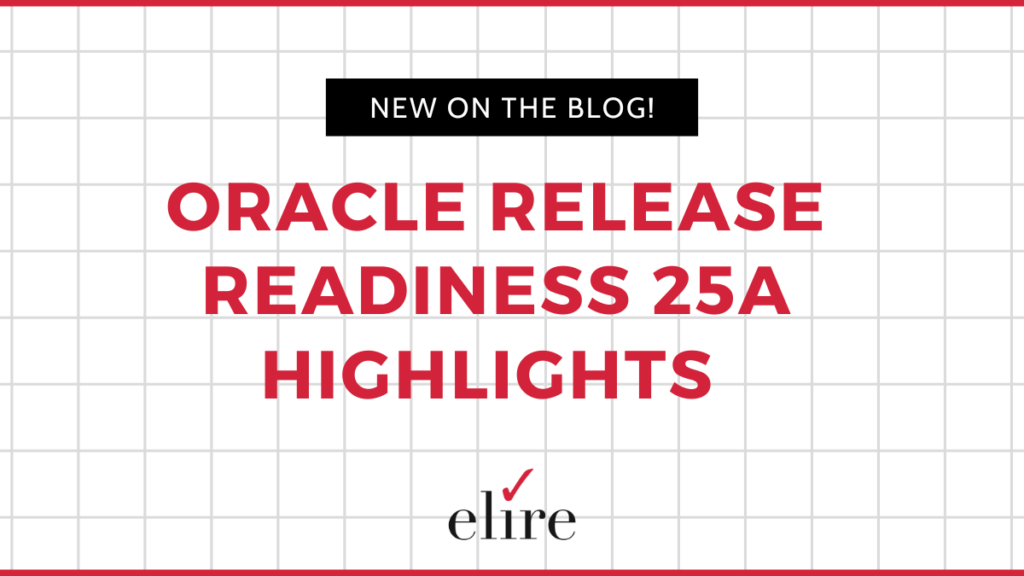
Oracle Fusion Applications have four quarterly releases per calendar year. Users of Cloud applications can choose from three cycles of quarterly updates:
- January/April/July/October
- February/May/August/November (schedule for Payroll customers)
- March/June/September/December
By default, non-production Oracle Cloud environments are updated on the first Friday of the quarterly update month. Production environments are updated on the third Friday of your quarterly update month. In this blog, we’ll recap the key areas affected by the 25A release update users should be aware of.
Collaboration Messaging Framework
Feature: Redwood – Manage Collaboration Messaging Documents Using a Redwood Page
The Redwood user experience offers enhanced accessibility, productivity, and ease of use in performing daily tasks. Using this new task, you can enable individual documents for B2B messaging rather than business processes as in releases prior to 25A. Set-up is required for this feature.
Payables
US 1099 Electronic and Forms Reporting Changes for Tax Year 2024
Users are now able to generate electronic files for Forms 1099-MISC, 1099-NEC and 1096, according to the specifications for tax year 2024 published by the U.S. Internal Revenue Service. The Manage Tax Regions page includes the following updates to the Combined Federal/State Filing Program:
- Rhode Island is added to the list with code 44
- District of Columbia is reassigned code 11
- Pennsylvania is reassigned code 42
Expenses
Expense Receipt Capture and Matching Using Document IO for Touchless Expenses with J.P. Morgan Corporate Cards
Users of Cloud ERP Touchless Expenses with J.P. Morgan Corporate Cards can now automatically extract expense attributes from expense receipts in multiple languages using the Document IO Agent. This will result in increased accuracy and automated matching of credit card charges during expense creation, thereby minimizing user inputs. This feature is available exclusively for customers using Touchless Expenses with J.P. Morgan Corporate Cards.
Assets and Lease Management
Lease Liability for Foreign Currency Migrated Leases
In Cloud ERP, users can now account for lease liability using the current foreign currency conversion rate when migrating foreign currency denominated leases. Lessees may enter leases with lease payments denominated in a currency different from the ledger currency.
Making lease payments denominated in a foreign currency is a monetary liability that must be recalculated each reporting period at the current foreign currency conversion rate, with any changes recognized in the income statement. Business benefits include enhanced compliance with lease accounting standards for foreign currency denominated leases and improved operational efficiency with streamlined accounting when migrating existing portfolios.
Lease Migration with Gross Right-of-Use Asset and Accumulated Amortization
With lease migration and gross right-of-use asset and accumulated amortization, users are able to capture the right-of-use accumulated amortization balance when importing midlife leases. This means users can account for the gross right-of-use asset balance and the accumulated amortization separately when booking migrated leases.
Receivables and Cash
Automatic Adjustments to Underpayments During Lockbox Processing
Consider setting up lockbox processing to create adjustment entries for underpaid receipts. Organizations often receive receipt amounts that are less than the customer invoice open balance, for example, due to bank charges or other similar fees.
The setup for automatic adjustments uses a tolerance limit amount, together with a Match Payment with Invoice AutoCash rule and a Receipt Application Exception Rule for underpayments. This feature requires set up.
Receivables Invoice Processing
Users can control the completion of imported third-party transactions with Receivables Invoice Processing. Configure and assign a transaction source and transaction type to specific sets of imported transactions for review and approval after transaction creation and before transaction completion. In addition, approvers can review Pending Approval transactions and their payment schedule before transaction completion. These enhancements provide additional control options for Receivables transactions, building on the Receivables Transaction Review and Control feature from update 24D.
General Ledger
Extreme Scale and Monitor for Accounting Hub Import Using a REST API
In Cloud ERP, users can achieve highly elastic and parallel processing of large sets of transactions during imports into Accounting Hub source applications. Orchestrate downstream accounting and posting processes with API-based access to transaction processing metrics, which can be used for building monitoring dashboards to resolve exceptions faster. As an example, administrators can report on the number of successfully processed transactions, transactions with exceptions and their recommended solutions, or transaction processing volume by ledger and source application.
Automatic Preparation for Large Volume Transactions
Automatically partition a single Accounting Hub transaction consisting of hundreds of thousands of lines into smaller transactions during the import process. Create Accounting can then process the smaller transactions in parallel to achieve faster completion time. Set up is required for this feature.
Supply Chain Management
Manage Flow Schedules for Manufacturing Execution on a Production Line
Flow manufacturing applies to a subset of manufacturers that run uninterrupted production lines at a constant rate to make similar products, generally in bulk and with a repetitive process. Production is managed through flow schedules that is created and scheduled based on the line rate and available working hours.
Users of Supply Chain Management can create a flow schedule based on the selected flow manufacturing work definition to make a standard or configured product on a production line at a certain rate. Users can manually schedule and sequence flow schedules for a mix of products to level load a production line and synchronize production activities with daily customer demand.
You can also fulfill back-to-back supply requests from Order Management with flow schedules, through Supply Chain Orchestration (SCO). SCO sends a flow schedule where users can create request to manufacturing to fulfill back-to-back supply requests. SCO also manages any changes that happen either on the back-to-back sales order or on the flow schedules to keep the demand and supply in sync. Set-up is required to enable this feature.
Define Pull Sequences and Generate Supplier and Intraorganization Kanban Cards
Kanban is typically used as a just-in-time inventory replenishment method to manage material supply based on actual consumption. A Kanban card accompanies a standard size bin that signals when material needs to be replenished from an internal or external source. For items replenished using Kanbans, users can now define replenishment chains as the series of pull sequences that pull materials between the point of supply and point of use. For example, users can replenish materials from another Kanban location in the organization or supplier to the supply subinventory for an operation in a flow production line. This feature requires set-up.
Redwood – Fulfill Transfer Requests from Item Quantities Page in Oracle Inventory Management
SCM users can initiate transfer requests via the redesigned Item Quantities page in Oracle Inventory Management. Inventory Management will request supply transfer to Oracle Supply Chain Orchestration, which then requests Inventory Management to create a transfer order. Orchestration now accepts more attributes for item quantities and shortages.
Procurement
Redwood – Use Redwood-Style Procurement Notifications
Users can send workflow notifications in a Redwood style and format for procurement documents and transactions. This update brings a consistent and fresh look to both email and worklist notifications, providing a seamless Redwood user experience. Set-up is required to enable this feature.
Authors
-

Samira has been consulting for the entirety of her career. She started with implementing Oracle EBS and began working with Oracle Cloud in late 2015. She has worked on Oracle Cloud implementations and supported many projects, and is certified in Oracle Accounts Payables and Oracle Accounts Receivables.
View all posts -

Ms. Caron serves as Elire's Marketing Manager, specializing in content strategy and digital media communications. Maddie works to deliver relevant industry updates and technical blog posts to educate and engage Elire's audience.
View all posts
